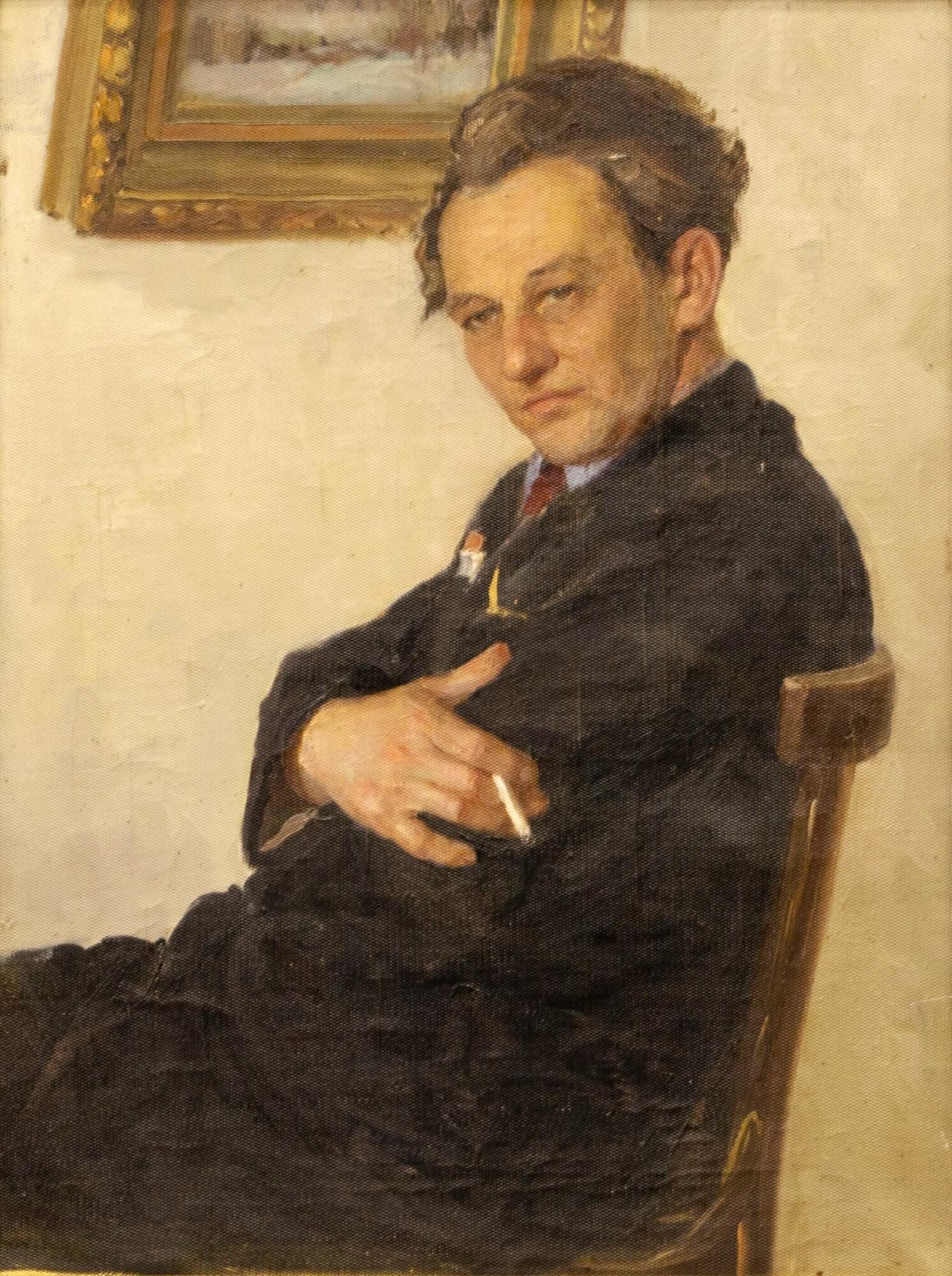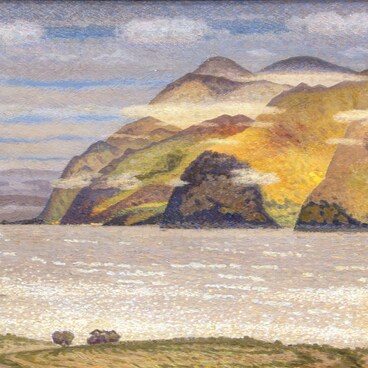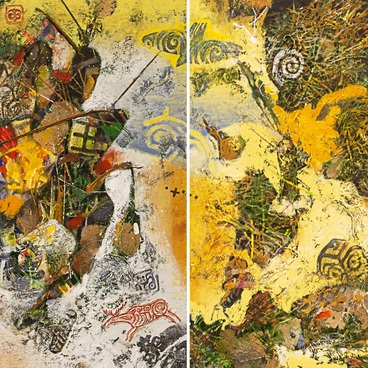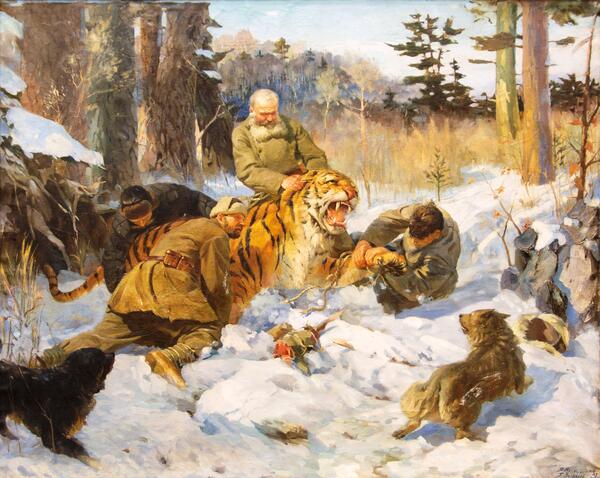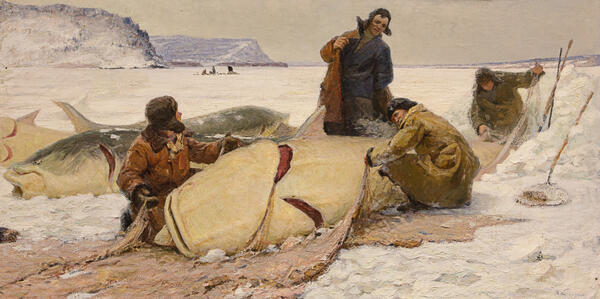Grigory Stepanovich Zorin (1919–2006) was called “the legend of the Russian Far Eastern painting” and “the singer of the clanking shackles”. Abandoning his studies at the Irkutsk Art School, he went to the front, served in Manchuria, and received awards for his service.
Having come to Khabarovsk after the war, Grigory Zorin began working in the regional Soviet Cooperative Association “Artist” (“Vsekokhudozhnik”). He was elected as the chairman and member of the board of the Artists’ Union in the Khabarovsk region; he also invited Alexey Fedotov, Boris Shakhnazarov, and Alexander Maksimovsky to come work in Khabarovsk. Researchers describe Zorin’s style as “severe”: his favorite topics include the development of the Russian Far East, the Civil War on the Far Eastern Front, and political prisoners. In search of natural materials and expressive characters, Grigory Zorin traveled extensively along the Amur River and also portrayed his contemporaries.
A graduate of the Blagoveshchensk Art College, Yakov Kurilenko worked as a teacher before the war, then served in the Navy. Demobilized in 1946, Kurilenko joined the “Vsekokhudozhnik” in Khabarovsk. Between 1950 and 1962, he lived and worked in Komsomolsk-on-Amur, sometimes collaborating with Grigory Zorin.
Zorin and Kurilenko worked together on this portrait of Georgy Alexandrovich Tsivilyov, who meant a lot to both of them.
Komsomolsk residents hold Georgy Tsivilyov in great esteem. He came to the construction site of Komsomolsk-on-Amur at the age of 18 and stayed there for the rest of his life. He went down in history as one of the first builders and the first professional artist in Komsomolsk-on-Amur (and for a long time, he was the only one). He designed city community centers, parks and the Palace of Culture, and organized the first exhibition in the city. He created scenery and made sketches for the drama theater and supervised the series of satire window posters “Repel the Enemy” during the wartime. He illustrated the book “Our Father Amur” by Nikolay Pavlovich Zadornov, was the leader of the first art studio in Komsomolsk and mentored many young artists, including Alexander Abrosimov, Nikolay Muravlyov, and Yevgeny Korolenko.
Even with the endless hustle and bustle of being an organizer, Tsivilyov never stopped being an artist. His extensive artistic legacy includes both state-commissioned works and intimate portraits, filled with thoughtfulness and love for people.
The portrait by Zorin and Kurilenko depicts Georgy Tsivilyov two years before his death. His posture, the arms folded on his chest and his slightly sullen gaze betray fatigue, yet not full detachment: he appears attentive and pensive. According to his contemporaries’ recollections, at that time he still believed that he had not done enough to hold a personal exhibition.
Having come to Khabarovsk after the war, Grigory Zorin began working in the regional Soviet Cooperative Association “Artist” (“Vsekokhudozhnik”). He was elected as the chairman and member of the board of the Artists’ Union in the Khabarovsk region; he also invited Alexey Fedotov, Boris Shakhnazarov, and Alexander Maksimovsky to come work in Khabarovsk. Researchers describe Zorin’s style as “severe”: his favorite topics include the development of the Russian Far East, the Civil War on the Far Eastern Front, and political prisoners. In search of natural materials and expressive characters, Grigory Zorin traveled extensively along the Amur River and also portrayed his contemporaries.
A graduate of the Blagoveshchensk Art College, Yakov Kurilenko worked as a teacher before the war, then served in the Navy. Demobilized in 1946, Kurilenko joined the “Vsekokhudozhnik” in Khabarovsk. Between 1950 and 1962, he lived and worked in Komsomolsk-on-Amur, sometimes collaborating with Grigory Zorin.
Zorin and Kurilenko worked together on this portrait of Georgy Alexandrovich Tsivilyov, who meant a lot to both of them.
Komsomolsk residents hold Georgy Tsivilyov in great esteem. He came to the construction site of Komsomolsk-on-Amur at the age of 18 and stayed there for the rest of his life. He went down in history as one of the first builders and the first professional artist in Komsomolsk-on-Amur (and for a long time, he was the only one). He designed city community centers, parks and the Palace of Culture, and organized the first exhibition in the city. He created scenery and made sketches for the drama theater and supervised the series of satire window posters “Repel the Enemy” during the wartime. He illustrated the book “Our Father Amur” by Nikolay Pavlovich Zadornov, was the leader of the first art studio in Komsomolsk and mentored many young artists, including Alexander Abrosimov, Nikolay Muravlyov, and Yevgeny Korolenko.
Even with the endless hustle and bustle of being an organizer, Tsivilyov never stopped being an artist. His extensive artistic legacy includes both state-commissioned works and intimate portraits, filled with thoughtfulness and love for people.
The portrait by Zorin and Kurilenko depicts Georgy Tsivilyov two years before his death. His posture, the arms folded on his chest and his slightly sullen gaze betray fatigue, yet not full detachment: he appears attentive and pensive. According to his contemporaries’ recollections, at that time he still believed that he had not done enough to hold a personal exhibition.
